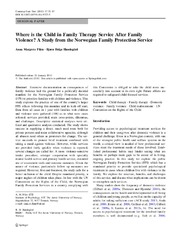Where is the Child in Family Therapy Service After Family Violence? A Study from the Norwegian Family Protection Service
Permanent link
https://hdl.handle.net/10037/9043Date
2015-01-21Type
Journal articleTidsskriftartikkel
Peer reviewed
Abstract
Extensive documentation on consequences of family violence laid the ground for a politically decided mandate for the Norwegian Family Protection Service (FPS) to prioritize families with children and violence. This study explores the practice of one of the country’s larger FPS offices following this mandate and its kick-off start. Data from all cases in 1 year with families with children and violence were gathered (106) as to what were cases referred, services provided, main cross-points, dilemmas, and challenges. Descriptive statistical analyses were utilized and qualitative analysis conducted. The study shows success in supplying a direct, much used route both for private persons and main collaborative agencies, although all abusers need others as promoters for change. The service succeeds to pioneer brief treatment combined with taking a stand against violence. However, while services are provided fairly quickly when violence is reported, several changes are called for: A more violence-sensitive intake procedure, stronger cooperation with specialty mental health service and primary health service, extended use of assessment tools and outcome measures. Given the nature of violence, particularly follow up measures are required. However, first and foremost, the study calls for a better inclusion of the child. Despite mandated priority, a major neglect of children takes place. In line with the UN Convention on the Rights of the Child, the Norwegian Family Protection Services in a country complying with this Convention is obliged to take the child more successfully into account in its own right. Future efforts are required to safeguard child-focused services.
Description
Published version. Also available at Springer via http://doi.org/10.1007/s10591-014-9323-5.
Publisher
SpringerCitation
Contemporary family therapy 2015, 37(1):72-87Metadata
Show full item recordCollections
Related items
Showing items related by title, author, creator and subject.
-
"What's happened to this family anyway?" : the disintegration of the American family in selected plays by O'Neill, Miller, and Shepard
Mathisen, Kari (Master thesis; Mastergradsoppgave, 2009-06)This thesis examines the disintegration of the American family as depicted in selected plays by Eugene O’Neill, Arthur Miller, and Sam Shepard. Four plays are central: Long Day’s Journey into Night (1956), Death of a Salesman (1949), Buried Child (1978), and True West (1980). (Journey and Salesman constitute my major focus and serve to generate my thesis statement, while Buried Child and True West ... -
Family assessment conversations as a tool to support families affected by parental mental illness: a retrospective review of electronic patient journals
Lauritzen, Camilla; Kolmannsskog, Anne Berit; Iversen, Anette Christine (Journal article; Tidsskriftartikkel; Peer reviewed, 2018-04-24)<p><i>Background</i>: Previous research has shown a link between parental mental illness and adverse development in their offspring. In Norway, it is mandatory for health professionals to identify if patients in adult mental health services have children, and subsequently to provide support for the children. An important tool to detect if families are affected by parental mental illness and to ... -
The role of attitude, preference conflict, norms, and family identity in explaining intention/behavior toward fish consumption in Vietnamese families
Le, Chi Cong (Master thesis; Mastergradsoppgave, 2010-05-16)The main objective of the thesis is to explore and test the roles of attitude, preference conflict, norms and family identity in explaining intention/behavior toward fish consumption in Vietnamese families. This study utilizes a theoretical framework based on the Theory of Planned Behavior, but more focused on some other variables (ambivalence, family conflict and identity) in an extended model. The ...


 English
English norsk
norsk


